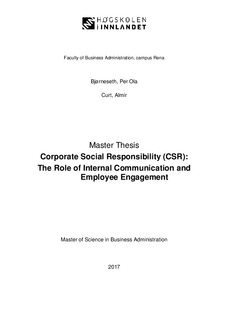| dc.description.abstract | Abstract (engelsk sammendrag)
The purpose of this study is to get a deeper understanding of how companies communicate their CSR initiatives and issues to internal stakeholders. The main research question is: “How do companies communicate their CSR initiatives in order to create engagement and commitment among internal stakeholders?”. This is followed by four supplementary research questions: 1) “To what extent are internal stakeholders aware of and engaged in the companies CSR initiatives?”; 2) “To what extent are internal stakeholders involved in CSR initiatives?”; 3) “Which message channels are being used for communicating CSR initiatives?” and 4) “How does the company’s external communication affect internal stakeholders?”. The research questions are answered through a qualitative case study consisting of three large regional companies in the municipality of Hedmark in Norway. The data was gathered through semi-structured interviews with both managers and employees, in total 14 respondents. The main findings show that the awareness and engagement of CSR is high among most of the employees. The main underlying cause of this, in this case, is the degree of involvement, which seems to be the utmost important factor for increased commitment and engagement to CSR and their associated activities. The most used communication channels are intranet, e-mails, face-to-face, department-, house- and video meetings. However, the preferred channel among internal stakeholders turned out to be face-to-face communication, with the desire of having the opportunity to give feedback and suggestions for improvement. The companies in this study seemed good at involving employees on top- and middle manager level. On lower positions, however, the involvement was arguably at a bare minimum, with the consequence of low commitment and engagement. The company’s own websites and annual reports seem to have little to no significant impact on employees, whereas social media and newspaper articles stand higher on the perceived impact – something perhaps overlook, but a considerably important channel for reaching employees. | nb_NO |
